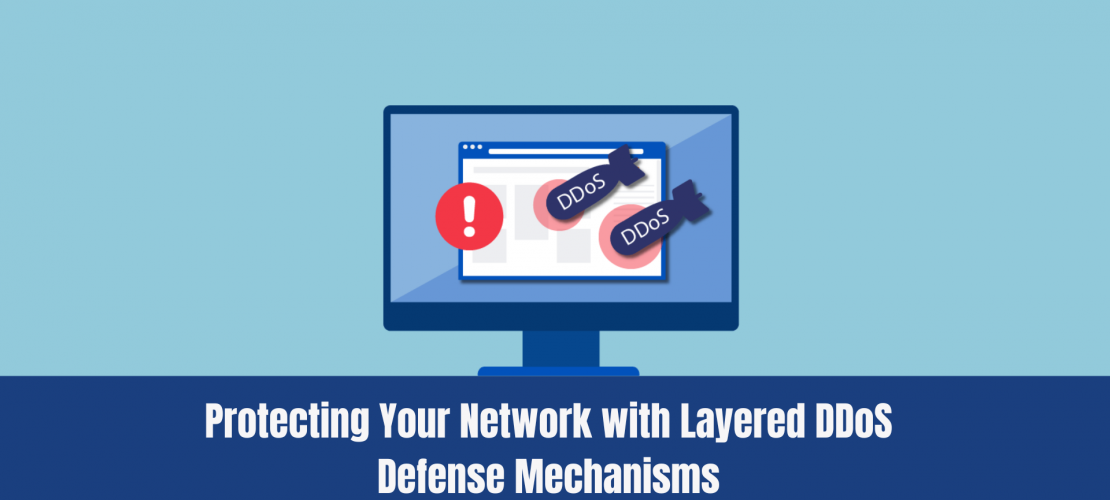DDoS attacks are one of the most common types of cyber attacks that can cause significant damage to businesses and organizations. These attacks are used to overwhelm the target network with a flood of traffic, resulting in a denial of service for legitimate users. To protect against these attacks, organizations need to implement layered DDoS defense mechanisms.
Layered DDoS defense is an approach that involves using multiple technologies and techniques to protect against DDoS attacks. Each layer of defense provides a unique set of protection mechanisms, making it difficult for attackers to bypass all of them. In this blog post, we will discuss the importance of layered DDoS defense mechanisms and the various technologies and techniques that can be used to implement it effectively.
Why Layered DDoS Defense Mechanisms are Important:
DDoS attacks are becoming increasingly sophisticated, making it difficult for traditional security measures to defend against them. Attackers are constantly finding new ways to bypass security measures and launch attacks. Layered DDoS defense mechanisms provide multiple layers of protection, making it harder for attackers to penetrate the network and launch an attack.
Layered DDoS defense also ensures that if one layer of defense fails, there are other layers of protection in place to prevent the attack from succeeding. This approach can help mitigate the impact of an attack and reduce the likelihood of a successful DDoS attack.
Layered DDoS Defense Mechanisms:
- Network Segmentation:
Network segmentation is the process of dividing a network into smaller sub-networks. This approach helps to limit the spread of an attack by isolating infected devices from the rest of the network. By segmenting the network, administrators can prevent an attacker from gaining access to the entire network, making it more difficult to launch a successful DDoS attack.
- Firewall:
Firewalls are essential components of any network security strategy. They provide a barrier between the network and the internet, allowing administrators to control access to the network. Firewalls can be used to block traffic from known malicious IP addresses, preventing DDoS attacks from reaching the target network. Firewalls can also be used to enforce access policies and prevent unauthorized access to the network.
- Intrusion Detection and Prevention Systems (IDPS):
Intrusion detection and prevention systems are used to monitor network traffic for suspicious activity. They can be used to detect and prevent DDoS attacks by analyzing network traffic patterns and blocking traffic from known malicious sources. IDPS systems can also be used to block traffic that is not compliant with network policies.
- Load Balancers:
Load balancers are used to distribute network traffic across multiple servers. They can be used to prevent DDoS attacks by distributing traffic across multiple servers, preventing any one server from being overwhelmed by traffic. Load balancers can also be used to monitor network traffic and block traffic from known malicious sources.
- Content Delivery Networks (CDNs):
CDNs are used to distribute content across multiple servers, improving performance and reducing the load on individual servers. CDNs can also be used to prevent DDoS attacks by distributing traffic across multiple servers. By distributing traffic across multiple servers, CDNs can absorb the impact of a DDoS attack, preventing any one server from being overwhelmed.
Best Practices for Implementing Layered DDoS Defense Mechanisms:
- Perform Regular Risk Assessments:
Regular risk assessments can help identify vulnerabilities in the network and identify areas that need additional protection. By identifying vulnerabilities and risks, administrators can implement additional security measures to protect against DDoS attacks. - Use Multiple Layers of Protection:
Using multiple layers of protection is essential for effective DDoS defense. Each layer provides a unique set of protection mechanisms, making it more difficult for attackers to penetrate the network and launch an attack. - Monitoring and Analysis:
In order to ensure that your layered DDoS defense mechanisms are working effectively, it is important to constantly monitor and analyze your network traffic. By monitoring and analyzing your network traffic, you can quickly identify any unusual spikes in traffic or patterns that may indicate a DDoS attack. - Response Plan:
Having a clear and effective response plan in place is critical for mitigating the effects of a DDoS attack. It is also important to have a communication plan in place, which should outline how you will communicate with your stakeholders, customers, and the public in the event of a DDoS attack. - Ongoing Evaluation:
Finally, it is important to regularly evaluate and update your layered DDoS defense mechanisms to ensure that they remain effective against the latest threats. This includes conducting regular penetration testing to identify vulnerabilities, staying up-to-date on the latest threat intelligence, and adjusting your defense mechanisms as necessary.




